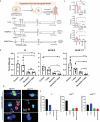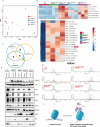This is a preprint.
HER2; p53 Co-mutated Cancers Show Increased Histone Acetylation and are Sensitive to Neratinib plus Trastuzumab Deruxtecan
- PMID: 40672227
- PMCID: PMC12265670
- DOI: 10.1101/2025.07.06.663368
HER2; p53 Co-mutated Cancers Show Increased Histone Acetylation and are Sensitive to Neratinib plus Trastuzumab Deruxtecan
Abstract
In metastatic breast cancer, HER2-activating mutations often co-occur with TP53 mutations, a combination linked to poor response to neratinib and worse prognosis. To model this clinical challenge, we bred HER2 V777L transgenic mice with two TP53 mutant alleles: TP53 R172H (the murine homolog of human TP53 R175H) and TP53 fl/fl, which mimics p53 truncations common in human tumors. TP53 mutations accelerated tumor development and reduced survival in HER2-mutant mice. These co-mutant tumors were resistant to neratinib but remained sensitive to exatecan, the topoisomerase I (TOP1) inhibitor payload in trastuzumab deruxtecan (T-DXd). Mechanistically, TP53 mutant tumors exhibited upregulation of histone acetylation, hypertranscription of DNA repair factors, increased chromatin accessibility, and rendered cells more susceptible to TOP1 inhibitors via G2/M arrest and apoptosis. This vulnerability is dependent on transcriptional activity of TP53 mutations, highlighting a novel strategy to treat HER2;TP53 co-mutant breast cancers using TOP1-targeted therapies.
Keywords: Breast cancer; histone modification; neratinib; p53 mutant; trastuzumab deruxtecan.
Conflict of interest statement
Conflict of Interest Disclosures: R. Bose received a research grant from Puma Biotechnology, Inc. and has performed consulting on a HER2 clinical trial for Genentech. Neratinib used in this study was provided by Puma Biotechnology, Inc.
Figures







Similar articles
-
Long Durable Response With Trastuzumab Deruxtecan Monotherapy in a Triple-Negative Metastatic Breast Cancer Patient With Human Epidermal Growth Factor Receptor 2 Mutation: A Long-Term Follow-Up and Literature Review.J Med Cases. 2025 Jun 16;16(6):212-221. doi: 10.14740/jmc5136. eCollection 2025 Jun. J Med Cases. 2025. PMID: 40642740 Free PMC article.
-
Efficacy of anti-HER2 drugs in the treatment of patients with HER2-mutated cancers: a systematic review and meta-analysis.Clin Exp Med. 2023 Nov;23(7):3205-3216. doi: 10.1007/s10238-023-01072-7. Epub 2023 Apr 30. Clin Exp Med. 2023. PMID: 37120775
-
Summary of Research: Efficacy of Trastuzumab Deruxtecan in HER2-Expressing Solid Tumors by Enrollment HER2 IHC Status: Post Hoc Analysis of DESTINY-PanTumor02.Adv Ther. 2025 May;42(5):2015-2018. doi: 10.1007/s12325-024-03080-9. Epub 2025 Mar 6. Adv Ther. 2025. PMID: 40048102 Free PMC article.
-
Trastuzumab-containing regimens for metastatic breast cancer.Cochrane Database Syst Rev. 2014 Jun 12;2014(6):CD006242. doi: 10.1002/14651858.CD006242.pub2. Cochrane Database Syst Rev. 2014. PMID: 24919460 Free PMC article.
-
Datopotamab Deruxtecan in Advanced or Metastatic HR+/HER2- and Triple-Negative Breast Cancer: Results From the Phase I TROPION-PanTumor01 Study.J Clin Oncol. 2024 Jul 1;42(19):2281-2294. doi: 10.1200/JCO.23.01909. Epub 2024 Apr 23. J Clin Oncol. 2024. PMID: 38652877 Free PMC article. Clinical Trial.
References
-
- Bose R, Kavuri SM, Searleman AC, Shen W, Shen D, Koboldt DC, Monsey J, Goel N, Aronson AB, Li S, Ma CX, Ding L, Mardis ER, Ellis MJ. Activating HER2 mutations in HER2 gene amplification negative breast cancer. Cancer Discov. 2013;3(2):224–37. Epub 20121207. doi: 10.1158/2159-8290.CD-12-0349. - DOI - PMC - PubMed
-
- Cheng X, Sun Y, Highkin M, Vemalapally N, Jin X, Zhou B, Prior JL, Tipton AR, Li S, Iliuk A, Achilefu S, Hagemann IS, Edwards JR, Bose R. Breast Cancer Mutations HER2V777L and PIK3CAH1047R Activate the p21-CDK4/6-Cyclin D1 Axis to Drive Tumorigenesis and Drug Resistance. Cancer Res. 2023;83(17):2839–57. doi: 10.1158/0008-5472.Can-22-3558. - DOI - PMC - PubMed
Publication types
Grants and funding
LinkOut - more resources
Full Text Sources
Research Materials
Miscellaneous
